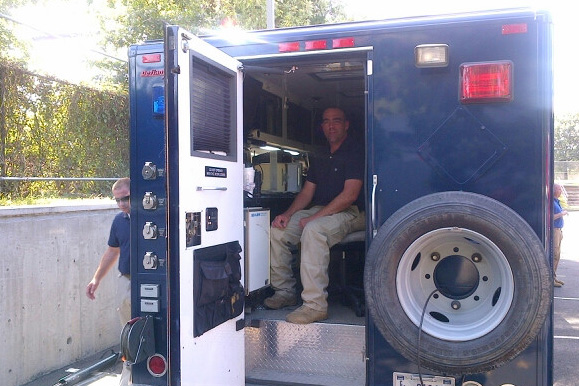// NEWS RELEASE
Interagency Collaboration Boosts Mobile Analytical Capability for Delaware Civil Support Team
U.S. Army Lab provide vital support to first responders of a WMD chemical, biological or nuclear event.
CCDC Chemical Biological Center Public Affairs | January 28th, 2016
Interagency Collaboration Boosts Mobile Analytical Capability for Delaware Civil Support Team
U.S. Army Lab provide vital support to first responders of a WMD chemical, biological or nuclear event.
DEVCOM CBC Public AffairsJanuary 28th, 2016

The 31st CST’s Analytical Laboratory System can identify chemical warfare agents on-scene
Large-scale events require high levels of security across multiple agencies, each with a heightened sense of vigilance and responsibility. In order to bolster its mobile analytical capabilities, the 31st Civil Support Team (CST) in Delaware has partnered with ECBC’s Environmental Monitoring Laboratory (EML) in an intensive work-study program designed to advance the CST’s technical depth of expertise across a variety of platforms.
CSTs are a National Guard resource that provide local and state authorities with the skills and expertise to prevent and/or respond to weapons of mass destruction events that are chemical, biological or nuclear related. Captain Robert “Dale” Annis is the science officer for the 31st CST, and is responsible for the Analytical Laboratory System—a six-wheeled truck that contains a full suite of analytical equipment needed to accurately identify agents and hazardous substances. It is his job to quickly assess the sample in question, and determine the current or projected consequences in relation to the situation in which it was collected.
“Out of all the equipment in the back of this truck, the most powerful piece I have is the telephone that’s hanging on the wall. I’ll call up ECBC and say, ‘This is what I’m seeing, and this is what I’m thinking. Does this make sense?’ That kind of reach back is absolutely critical.”
Capt. Robery ‘Dale” Annis, 31st Civil Support Team
“While on scene, my first concern is whether I can I clearly determine if the sample is WMD-related or if it requires deeper analysis. If it does, I need to know which government agency to send it to for further research,” said Annis, who has been on the Delaware CST for more than 10 years. Since January, he has participated in a work study program with ECBC’s EML, the first lab in the United States to meet requirements set forth by the Department of Defense Environmental Laboratory Accreditation Program for testing chemical warfare material.
“I’ve worked with at least five different analysts in the lab learning new test methods with the depot area air monitoring systems, developing agent standards, and using advanced software on the equipment. It’s been an incredibly valuable experience,” Annis said.
The hands-on experiential learning with ECBC experts has helped Annis enhance the qualitative services of the Analytical Laboratory System. By learning the quantitative methods utilized by the EML, Annis has greatly increased his ability to recognize the spectra produced by traditional chemical warfare agents thus increasing his ability to rapidly identify those agents. Boosting this capability is an advantage for the CST, which is often deployed for occasions that draw large crowds of people, the Presidential inauguration, professional sporting events, the Papal visit, or music concerts, where rapid answers are critical to civilian emergency managers.
Now, when Annis is on the scene and the mobile laboratory equipment is analyzing unknown samples, he can identify potential chemical warfare agents more quickly and more accurately, based on spectra he is now looking for. In addition to saving time, this also saves money. Instead of forwarding the sample for further analysis to a fixed laboratory, the CST can conduct more advanced sample analysis right at the given location. The CST unit is a critical decision point in the rapid response process, and as a result of more targeted extraction methods, can better advise response measures and determine the appropriate level of support needed depending on the scope of the sample.
“The knowledge that I’ve gained and the network that I’ve built has been a huge benefit of my experience,” said Annis. “This kind of interagency partnership reminds me that we’re all on the same team and in the end, it’s all our home that we’re trying to protect.”
The Most Important Piece of Equipment
The CST’s Analytical Laboratory System includes a broad range of equipment and capabilities, such as gas chromatography—mass spectrometry, Fourier transform infrared spectroscopy, polymerase chain reaction, electrochemiluminescence antibody testing for toxins, and pathogens.
The first time Annis visited ECBC was in 2006, when his team took part in ECBC’s Advanced CBRNE Training Program, led by ECBC biologist Carrie Poore, Ph.D. The program pairs external organizations with ECBC’s subject matter experts in a unique relationship that allows the scientists and engineers to share their knowledge, experience and talents through classroom learning, as well as hands-on exercises in a private neighborhood setting with actual chemical and biological production equipment and clandestine labs. ECBC has customized training objectives based on the CST unit’s needs, and it was Poore who ultimately facilitated the EML work study partnership.
“Not only am I relying on ECBC’s expertise while I’m there training, but also when I’m on site somewhere and have a question,” Annis said. “Out of all the equipment in the back of this truck, the most powerful piece I have is the telephone that’s hanging on the wall. I’ll call up ECBC and say, ‘This is what I’m seeing, and this is what I’m thinking. Does this make sense?’ That kind of reach back is absolutely critical.”
The U.S. Army Combat Capabilities Development Command (DEVCOM) leads in the discovery, development and delivery of technology-based capabilities to enable Soldiers to win our nation’s wars and come home safely. DEVCOM is a major subordinate command of the U.S. Army Futures Command. The DEVCOM Chemical Biological Center is the Army’s principal research and development center for chemical and biological defense technology, engineering and field operations. The DEVCOM Chemical Biological Center is headquartered at Aberdeen Proving Ground, Maryland.
